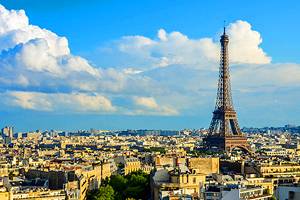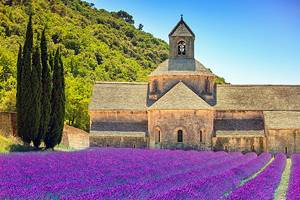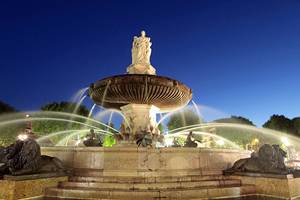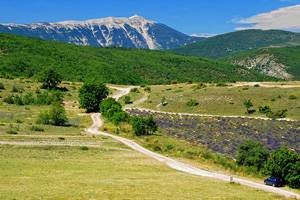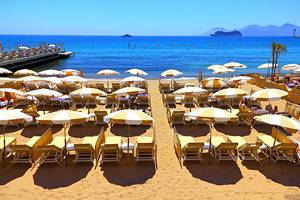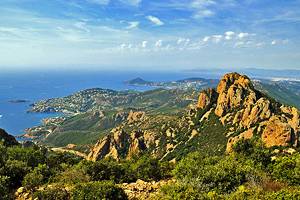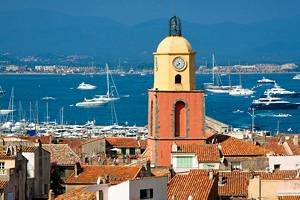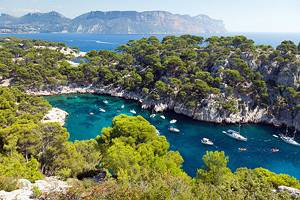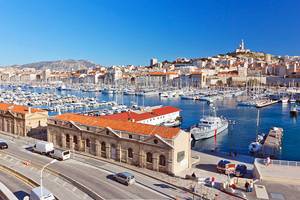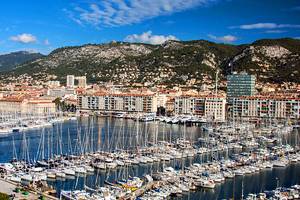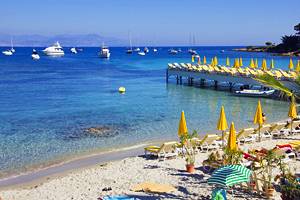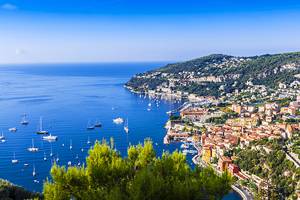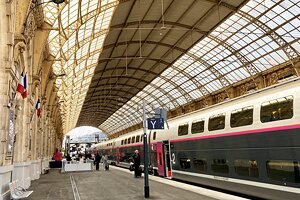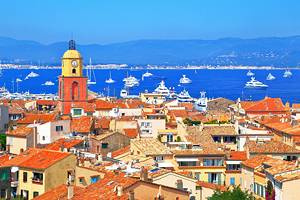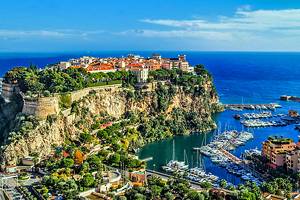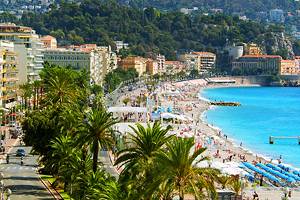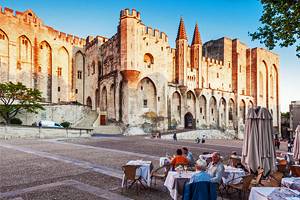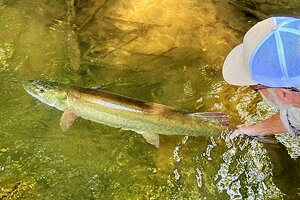25 Top-Rated Attractions & Scenic Drives in Provence
Provence is one of nature's most vibrant works of art. Everything appears brighter here than elsewhere in France: the sunshine, the red poppies, yellow sunflowers, and deep purple lavender fields. Even the traditional Provençal fabrics feature prints of intense colors.
From verdant rolling hills and quaint fishing ports to picturesque villages perched on rocky outcrops, each detail of the landscape seems designed to delight. It's no wonder the region charmed many famous painters, including Cézanne, Matisse, Chagall, Picasso, Vasarely, and Fernand Léger.
The art de vivre ("art of living") is a way of life in Provence, similar to la dolce vita in neighboring Italy. A sunny climate, slow-paced lifestyle, and rustic earthiness encourage relaxation. In Aix-en-Provence and Avignon, tourists and locals alike bask on the terraces of outdoor cafés, shop at open-air markets, and admire amazing art at top-notch museums.
Outside the cities are off-the-beaten-path destinations in the Haut-Vaucluse and the Luberon. These less-touristy corners of Provence are dotted with ancient Roman outposts, walled medieval towns, and fortified castles; orchards, olive groves, and woodlands blanket the bucolic landscape.
Throughout the region, you can enjoy delicious Mediterranean cuisine based on olive oil, vegetables, and aromatic herbs. Fresh local ingredients are transformed into specialties such as pistou, a basil and garlic sauce; bouillabaisse, a flavorful fish stew; fougasse, soft braided bread; and pissaladière, a pizza-like tart of caramelized onions, anchovies, and black olives.
For more ideas on the best places to visit in this famous region, read our list of the top attractions in Provence.
- 1. Aix-en-Provence: Quintessential Provence
- 2. Avignon: Medieval City of the Popes
- 3. Ancient Ruins and Provençal Traditions in Arles
- 4. Saint-Tropez's Seaside Glamour
- 5. Les Baux-de-Provence: A Historic Town in a Dramatic Setting
- 6. Marseille: Cosmopolitan Seaport
- 7. Saint-Paul de Vence: A Picture-Perfect Hilltop Village
- 8. Ancient Roman Ruins in Orange
- 9. Gordes: A Beautiful Village in a Natural Park
- 10. Archaeological Sites in Vaison-la-Romaine
- 11. Vence: A Picturesque Artists' Village
- 12. Saint-Rémy-de-Provence: Van Gogh's Artistic Inspiration
- 13. Salon-de-Provence: Historic Landmarks and Artisan Soaps
- 14. Grasse: Perfumes, Gardens, and Art
- 15. Sunbathing and Sightseeing in Fréjus
- 16. Cassis: A Quaint Fishing Village
- 17. Biot: An Ancient Perched Village with Artisan Boutiques
- 18. Saint-Paul-Trois-Châteaux: Culture, Cuisine, and Nature
- 19. Tarascon: Provençal Festivals and Fabrics
- 20. Mougins: Picasso's Favorite Hilltop Village
- 21. Lorgue: A Small Town with Grand Gastronomy
- 22. Seillans: A Beautiful Perched Village
- 23. Bargème: A Peaceful Countryside Retreat
- 24. Château de Rochegude
- 25. Aureille in Les Alpilles Mountains
- Scenic Drives through the Provence Countryside
- 1. Gorges du Verdon: Beautiful Views and Gourmet Cuisine
- 2. Gorges du Loup: Gorgeous Scenery & Hilltop Villages
- Map of Attractions & Scenic Drives in Provence
1. Aix-en-Provence: Quintessential Provence
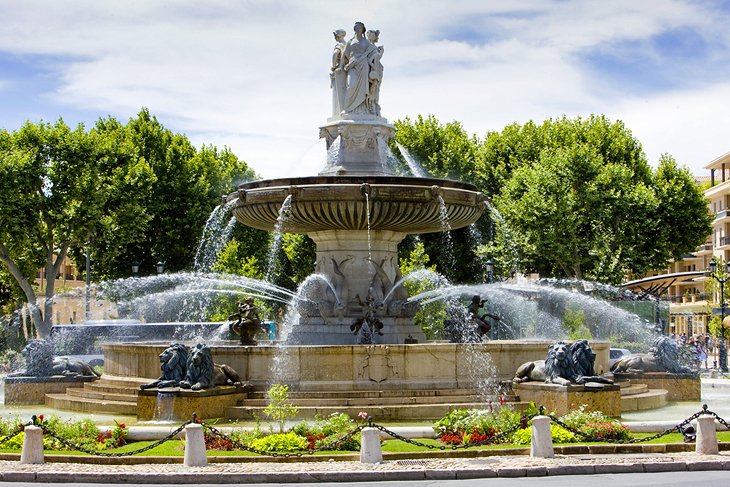
Aix-en-Provence has the elegance of Paris combined with the warmth of southern France. This traditional Provençal town is distinguished by its shady tree-lined streets, historic squares, and an abundance of ornate fountains (one thousand are scattered throughout the city).
The hub of Aix-en-Provence is the Cours Mirabeau, a broad boulevard with bustling outdoor cafés. Other places to visit are the Cathédrale Saint-Sauveur, with its flamboyant mix of architectural styles, and the Musée Granet, an exceptional fine arts museum with masterpieces by Ingres, Rembrandt, Rubens, Cézanne, Monet, and Picasso, among others.
If you love Post-Impressionist art, visit the Atelier de Cézanne (art studio) on the Colline des Lauves, where Cézanne painted his "still life" pieces. Near the studio is a spot on the Chemin de la Marguerite overlooking Mont Sainte-Victoire, the landscape Cézanne cherished and that inspired him to create many paintings.
Many travelers visit Aix-en-Provence to experience the traditional outdoor Provençal markets. A popular flower market takes place at the Place de la Mairie, while farmers markets are held at the Place des Prêcheurs, the Place Verdun, and the Place Richelme. Aix-en-Provence is renowned for artisanal culinary products, especially Calissons d'Aix, sweet almond candies.
Read More: Best Places to Visit in the South of France
2. Avignon: Medieval City of the Popes
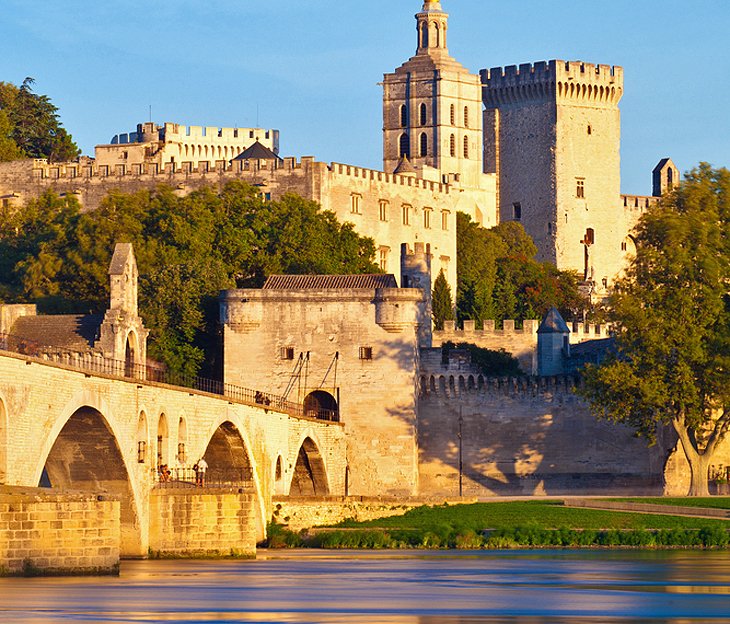
When describing Avignon, it's impossible to begin anywhere else than the Palais de Papes. This extraordinary UNESCO-listed palace was built in the early 14th century when the Catholic church moved the papal court from Rome to Avignon.
Daunting crenelated fortifications and massive defense towers distinguish the imposing structure, which is Europe's largest Gothic palace. Extravagant interior spaces hint at the lavish lifestyles of the nine Popes who lived here between 1309 and 1403.
Avignon has many other tourist attractions, including the Musée du Petit Palais. This exceptional fine arts museum displays works by the great masters from Italy: Giovanni Bellini, Sandro Botticelli, and Vittore Carpaccio, among others. The most acclaimed piece is Botticelli's La Vierge et l'Enfant (Madonna and Child) painting.
Two must-see churches include the 12th-century Basilique Métropolitaine Notre-Dame des Doms and the Provençal Romanesque Eglise Saint-Didier. Another famous sight is the Saint Bénézet Bridge (Pont d'Avignon), a graceful half-intact structure that partially spans the river.
Four kilometers across the river from Avignon is Villeneuve-lès-Avignon, renowned for the Chartreuse du Val de Bénédiction, a Carthusian monastery built by Pope Innocent VI.
About 20 kilometers from Avignon in the countryside of rolling hills, Châteauneuf-du-Pape is a medieval village where the Popes of Avignon built their summer palaces.
3. Ancient Ruins and Provençal Traditions in Arles
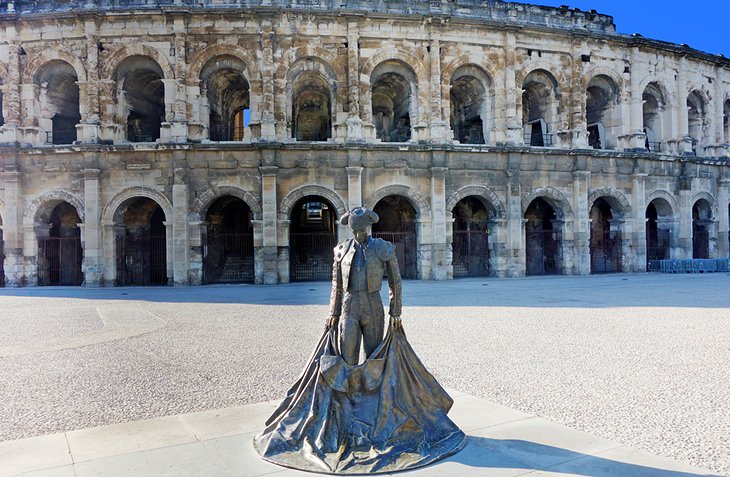
Steeped in history and drenched in sunshine, Arles has a fascinating heritage that dates back to antiquity. The town was an ancient Greek settlement and then became an important Roman colony in 46 BCE.
You will be dazzled by the UNESCO-listed monuments, including the Roman Amphitheater and the 12th-century Eglise Saint-Trophime. After visiting the many tourist sights, you'll enjoy soaking up the traditional Provençal ambience, by relaxing in the tree-shaded public squares, wandering the narrow pedestrian streets in the old town, and spending sunny afternoons at terraced outdoor cafés.
Vincent van Gogh lived in Arles from February 1888 until May 1889. You can follow in the artist's footsteps on the Van Gogh Pedestrian Path. This self-guided walking tour includes the sites in Arles that the inimitable artist captured on canvas, such as a café at the Place du Forum and the garden at the historic hospital of Arles.
4. Saint-Tropez's Seaside Glamour
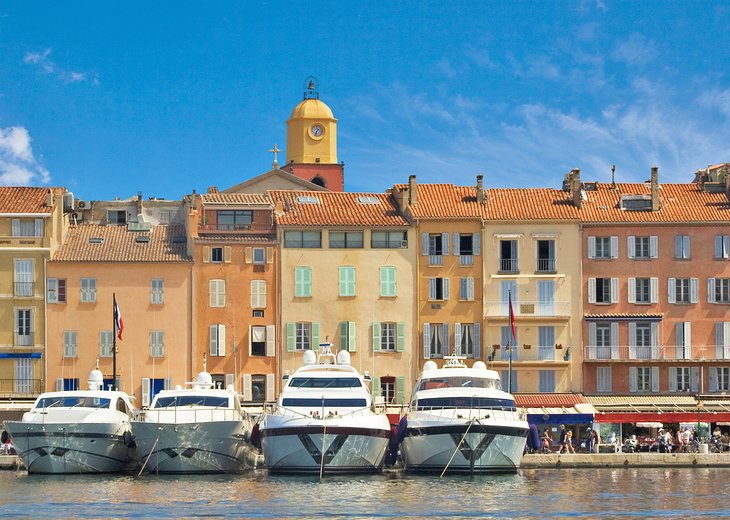
Beach lovers, rejoice! Saint-Tropez is one of the sunniest places on the French Riviera and has an extensive, palm-fringed sandy shoreline. Some beaches are private, but many are open to the public.
Saint-Tropez has a reputation for glitz and glamour. This resort certainly lives up to its image, from luxury yachts in the harbor to designer boutiques lining its cobblestone streets.
At heart, Saint-Tropez is a small Provençal town that has retained much of its authentic character. You might be surprised to discover its humble origins as a fishing village.
Locals play pétanque and socialize at the town's main square, the Place des Lices. For a taste of everyday life in Saint-Tropez, Tuesday or Saturday morning is a great time to visit the Place des Lices, when a traditional Provençal market is held here.
In addition to fun-in-the-sun vacation vibes, Saint-Tropez brims with cultural attractions and things to do. The Musée de l'Annonciade, has a superb collection of Impressionist art displayed in a 16th-century chapel. The old Citadel built in the early 1600s houses the Musée d'Histoire Maritime illustrating Saint-Tropez's maritime past.
Read More:
5. Les Baux-de-Provence: A Historic Town in a Dramatic Setting
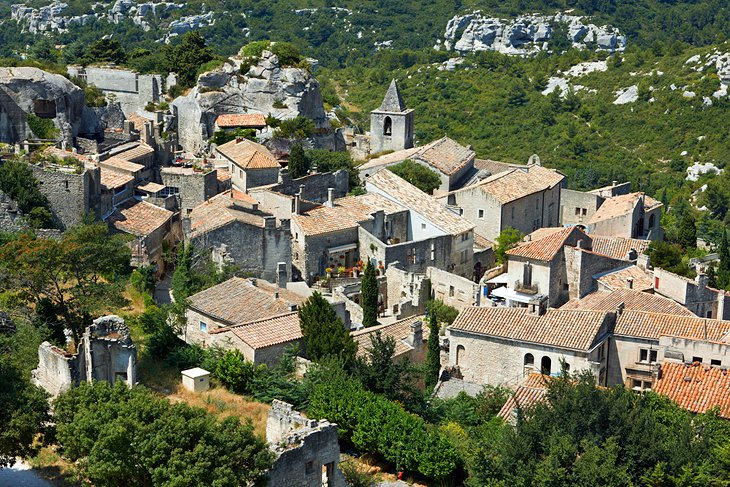
Perched on a rocky plateau, Les Baux-de-Provence takes its name from the Provençal word "Li Baus," which means "The Rocks." This stunning setting has earned the village a place on the Plus Beaux Villages de France (Most Beautiful Villages of France) list.
To visit the historic village of Les Baux-de-Provence, you must park in the lower part of the town and then walk up to the old town. This experience gives the impression of stepping back in time to the Middle Ages. Try to imagine the medieval troubadour culture of chivalry and romantic poetry that flourished here in the 12th and 13th centuries.
Begin a tour of the village at the Château des Baux-de-Provence, which stands at the edge of a steep limestone crag. The castle is in ruins, but the clifftop vantage point affords fabulous panoramic views of the landscape.
Wander the old cobblestone streets at leisure to discover the charm of Les Baux-de-Provence, with its atmospheric old stone buildings, shaded squares, and terraces overlooking the landscape. You will also find charming cafés, small boutiques, and inviting art galleries.
Be sure to see the Eglise Saint-Vincent, a 12th-century Romanesque church with modern stained-glass windows created by Max Ingrand, and the Musée Yves Brayer (in the 16th-century Hôtel des Porcelets) featuring the artist's finest paintings.
Les Baux-de-Provence is in the heart of the Alpilles Mountains, 20 kilometers north of Arles and 11 kilometers south of Saint-Rémy de Provence.
The Plâteau des Bringasses provides the best view of the village. From here, the view extends to Mont Ventoux and the Luberon in Haut-Vaucluse, the Rhône Valley, Aix-en-Provence, and Arles.
If you're looking for a luxury hotel in Provence, consider staying in this area. The five-star Baumanière Les Baux de Provence nestles at the foot of Les Baux-de-Provence village in the Vallon de la Fontaine. This Relais & Châteaux property has a restaurant with three Michelin stars, L'Oustau de Baumanière; a casual restaurant, La Cabro d'Or, that serves Provençal cuisine based on fresh local ingredients; and the Chocolaterie, an artisanal chocolate boutique.
Read More: Top-Rated Things to Do in France
6. Marseille: Cosmopolitan Seaport
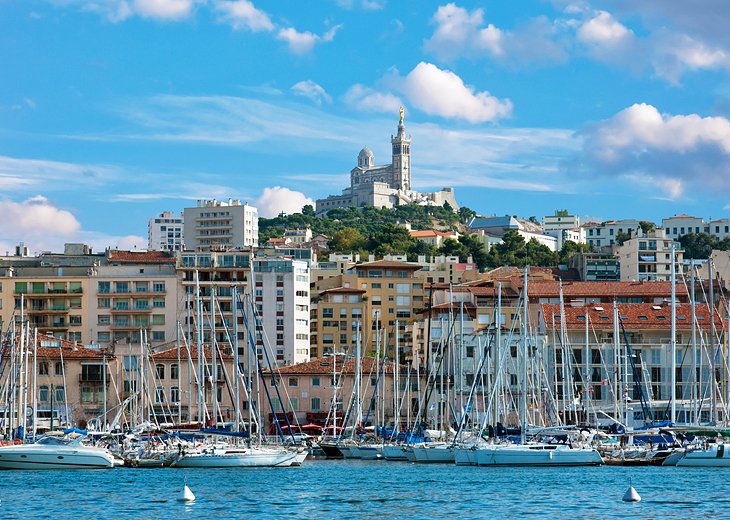
Marseille offers an appealing blend of Mediterranean scenery, multiethnic ambience, and urban grit. This bustling cosmopolitan city is the oldest in France and the second-largest after Paris. It's not a picture-postcard scene, but Marseilles does offer a real slice of life.
The sea is central to Marseille's existence, and many landmarks in Marseille offer views of the bay's deep blue waters. The city's most iconic church, the Basilique Notre-Dame de la Garde stands on a hillside overlooking the bay, and the terrace offers sensational coastal panoramas.
One of Marseille's top attractions, the Musée des Civilisations de l'Europe et de la Méditerranée illustrates the history of Mediterranean civilization. Check out the collections and then head to the museum's gardens for sweeping views of the coastline and the harbor.
For a taste of the city's culture and historic charm, stroll the winding streets of Le Panier to admire quaint pastel-painted houses, find a traditional Arab souk, and dine at an atmospheric Algerian restaurant or a classic French bistro. You should also stop at a waterfront restaurant in the Vieux Port (Old Port) to try the Marseille specialty of bouillabaisse (seafood stew).
A short ferry ride from the Marseilles port, the Château d'If on the Frioul Islands is a historic prison depicted in the Count of Monte Cristo, but today is a serene seaside destination where turquoise waters lap on pristine beaches. Another nearby nature escape is in the Calanques, magnificent fjord-like coves filled with pools of saltwater connected to the sea.
Read More:
7. Saint-Paul de Vence: A Picture-Perfect Hilltop Village
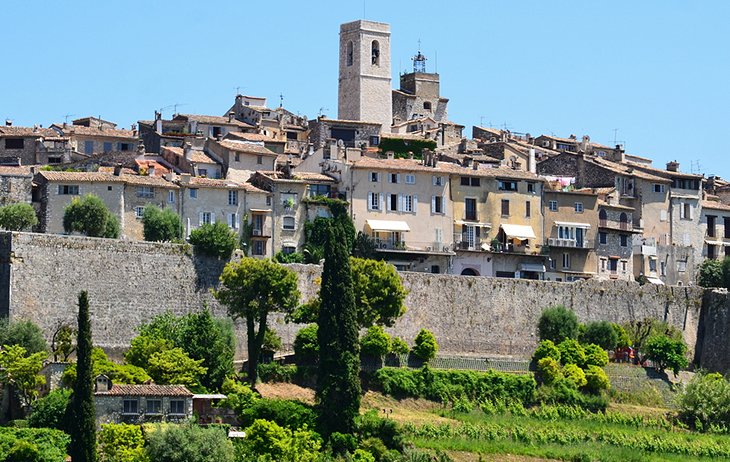
This dreamy hilltop village invites you to step back in time. Upon entering the ancient town gates, you are immersed in a medieval ambience. This walled medieval town includes labyrinthine cobblestone streets, narrow alleyways, pedestrian staircases, and small squares adorned with gurgling fountains.
The distance from favorite Côte d'Azur beach resorts, Nice, and Antibes, is less than 20 kilometers, but the village feels much farther away in spirit.
The spiritual center of Saint-Paul de Vence is represented by the Collegiate Church, built between the 14th and 17th centuries. The sanctuary has a Romanesque choir and a Baroque chapel containing precious relics.
Historically, a central gathering place in Saint-Paul de Vence was the Place de la Grande Fontaine, where the weekly market was held during the 17th century. Villagers drew water from the square's well and washed laundry in the washhouse area.
Also not to be missed is the Folon Chapel, which occupies the 17th-century Chapelle des Pénitents Blancs. The entire interior is adorned with contemporary mosaics, sculptures, paintings, and stained-glass windows by artist Jean-Michel Folon, which have a serene quality.
Since the 1920s, many artists have been drawn to Saint-Paul de Vence. The village's artistic heritage is on display at the Fondation Maeght, about one kilometer outside the medieval village. The permanent collection includes mosaics by Chagall; stained-glass windows by Georges Braque; paintings by Bonnard, Chagall, Kandinsky, and Léger; sculptures by Giacometti; and ceramics by Miró.
Saint-Paul de Vence boasts several fine dining options. On a quiet street near the village ramparts, the restaurant at the five-star Hôtel Le Saint Paul serves refined Mediterranean cuisine on a sunny flower-draped garden terrace. La Colombe d'Or hotel has welcomed many famous artists; the hotel's restaurant serves classic French cuisine in an elegant dining room or on the garden patio.
Read More: Best Towns in France
8. Ancient Roman Ruins in Orange
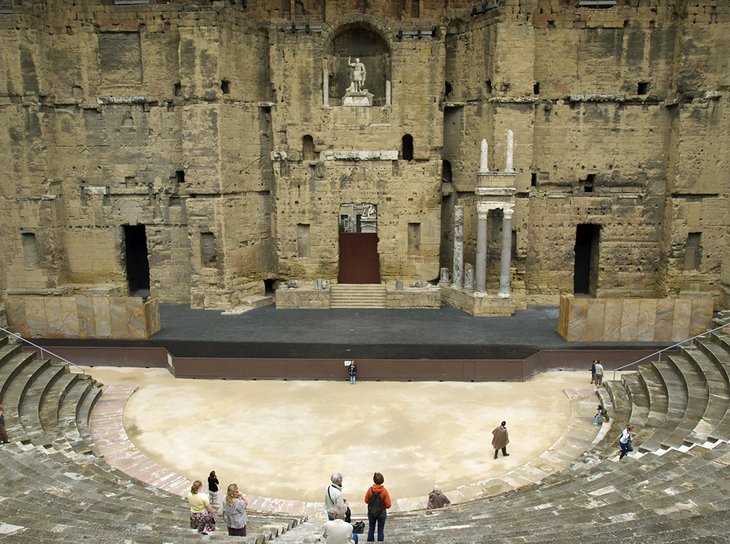
Amazing ancient Roman ruins await you in Orange. The town is surrounded by a landscape of farmlands, vineyards, and orchards in Provence's Haut-Vaucluse region, an area that flourished during antiquity.
Marvel over the UNESCO-listed 1st-century CE Théâtre Antique. This ancient theater was designed to fit a crowd of more than 7,000 spectators. Roman-era residents would pile into the theater to watch comedies, tragedies, dance performances, acrobatics, and juggling acts.
Today, the Théâtre Antique hosts a summertime festival called Les Chorégies d'Orange that includes opera, classical music, and ballet performances.
In a 17th-century mansion next to the Théâtre Antique, the Musée d'Art et d'Histoire displays an excellent collection of artifacts, antiquities, and artworks including historical paintings. Be sure to see the Mosaïque des Centaures, an impressive mosaic that was discovered in the Théâtre Antique.
Other interesting archaeological sights are the Arc de Triomphe, the triumphal arch dedicated to ancient Rome's Emperor Tiberius, and the Hémicycle, ruins of a Roman temple adjoining the Roman theater.
Read More: Top Attractions & Places to Visit in the Haut-Vaucluse, Provence
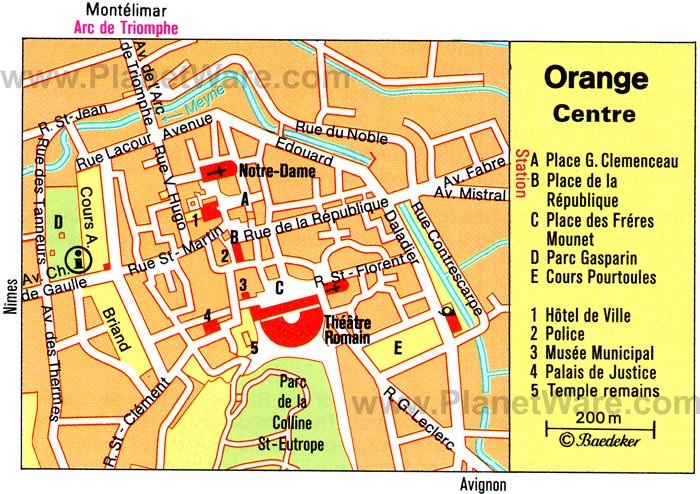
9. Gordes: A Beautiful Village in a Natural Park
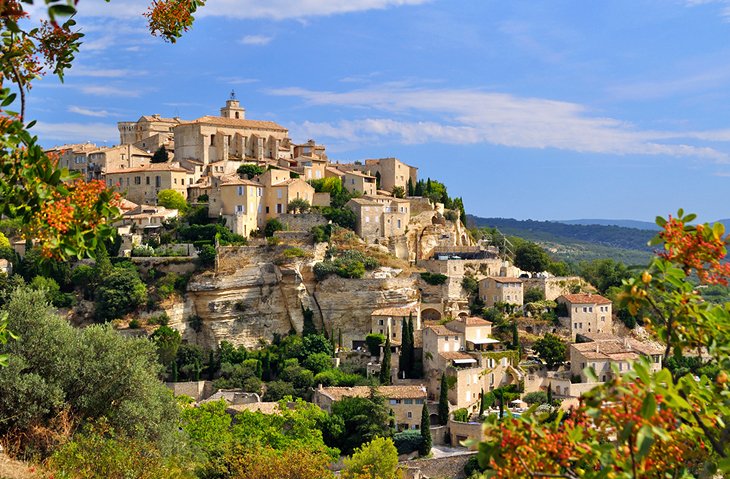
This characteristic village perché (perched village) is beautifully situated in the UNESCO-listed Luberon Natural Regional Park. Because of its dramatic hilltop setting and splendid architecture, Gordes has been named one of the Plus Beaux Villages de France, and many artists (including Victor Vasarély and Marc Chagall) have found inspiration for their paintings here.
Gordes abounds with all the charm of a Provençal medieval village. The 16th-century Château de Gordes is a fortified castle with imposing towers and an enormous entrance doorway. You can tour the château's interior to admire the monumental fireplace (classified as a Monument Historique) in the Salle d'Honneur (Hall of Honor).
A worthwhile detour from Gordes is the Abbaye de Sénanque, tucked into a valley of lavender fields five kilometers away. This 12th-century Romanesque building is considered one of the most interesting abbeys in France. The harmonious architecture reflects the Cistercian concepts of seclusion, simplicity, and spirituality.
You may take a self-guided tour of the Abbaye de Sénanque or join a guided tour with commentary in French (reservations recommended). The Abbaye de Sénanque also welcomes you to attend religious services and to participate in silent retreats.
10. Archaeological Sites in Vaison-la-Romaine
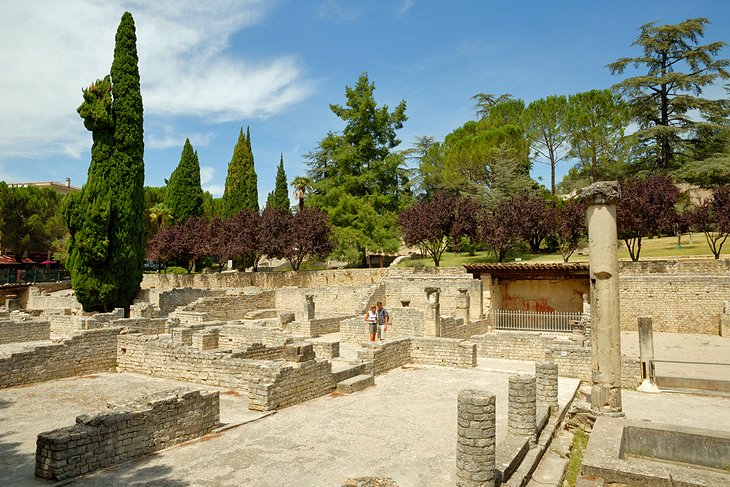
Vaison-la-Romaine (30 kilometers from Orange) is an excellent stop on an itinerary through Provence. At the foot of Mont Ventoux between the French Alps and the Mediterranean Sea, this town is known as "one of the most beautiful detours in France."
In this slow-paced town, time seems to stand still. Narrow cobblestone streets and an abundance of fountains and leafy plane trees lend a distinctive old-world character. Vaison-la-Romaine also boasts some of the most extensive Gallo-Roman ruins in France.
Begin exploring Vaison-la-Romaine in the Quartier de Puymin archaeological site, which reveals evidence of the Roman town that thrived from the 1st century BCE to the 4th century CE. At this site, you can see remnants of ancient houses and a porticoed sanctuary.
The Quartier de Puymin's well-preserved Théâtre Antique (Ancient Theater) hosts outdoor performances during the summertime.
Another highlight of the Quartier de Puymin is the Musée Archéologique Théo Desplans. This exceptional antiquities museum displays original statues (copies appear at the locations where they were found), frescoes, mosaics, decorative objects, jewelry, ceramics, and other items discovered at archaeological sites in Vaison-la-Romaine.
In the Quartier de la Villasse, you can see ancient paved streets with gutters and the remains of private houses of the 1st and 2nd century CE. Some of the original mosaic floors and columns of porticoed garden courtyards are still visible.
Three noteworthy historic churches in Vaison-la-Romaine are worth exploring: the Cathédrale Notre-Dame-de-Nazareth, an outstanding example of Provençal Romanesque architecture built in the 11th and 12th centuries; the Chapelle Saint-Quenin, another Romanesque church built in the 12th century; and the 15th-century Cathédrale Sainte-Marie-de-l'Assomption in the Haute Ville (Upper Town), the medieval quarter.
Vaison-la-Romaine hosts a traditional Provençal market on Tuesday mornings, with more than 400 stalls selling fresh fruits, vegetables, and flowers, as well as regional products like tapenade, fougasse bread, olives, black truffles, Provençal tablecloths, and handcrafted ceramics.
Summer is an especially enjoyable time to visit Vaison-la-Romaine, when the markets are at their busiest. There are also cultural events such as the Vaison Dance Festival and the Ancient Theater Week, both held at the ancient theater in July.
About 31 kilometers away from Vaison-la-Romaine is Mont Ventoux, a UNESCO-listed biosphere reserve. According to local legend, the poet Francesco Petrarch climbed the mountain in 1336. Today, the area has many hiking and biking trails. The trek to the Col des Tempêtes rewards with sensational panoramas.
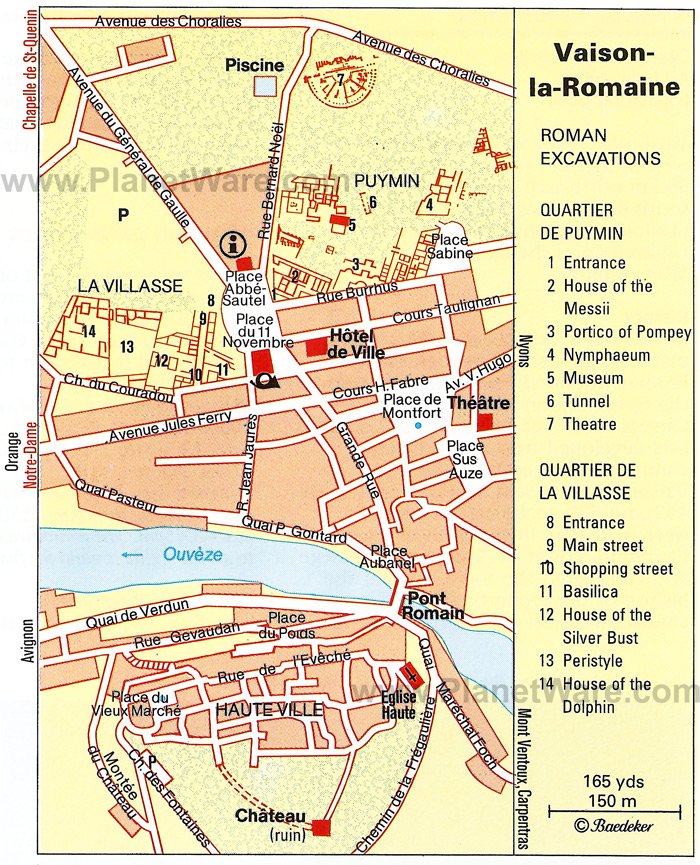
11. Vence: A Picturesque Artists' Village
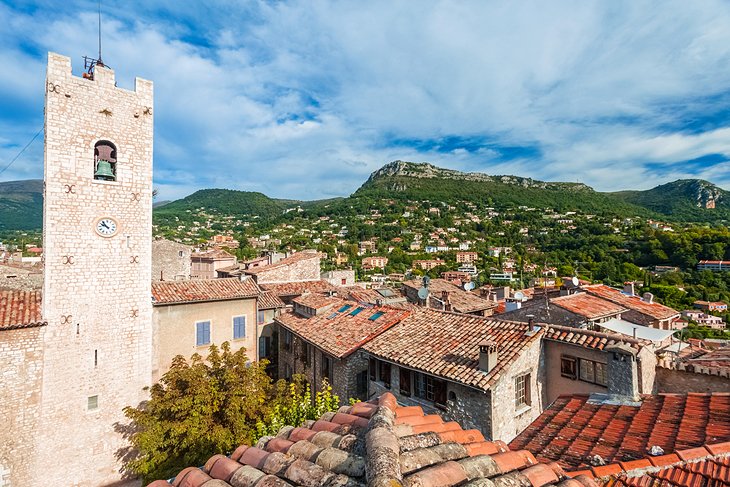
Well-preserved medieval walls enclose the enchanting hilltop town of Vence. Enter the Cité Historique (Historic City) through the Porte du Peyra. This gateway leads to a captivating pedestrian-only world of narrow cobblestone lanes and peaceful fountain-adorned squares.
Especially charming spots include the Place du Peyra, which has many restaurants and shops, and the Place Godeau, a shaded square often painted by artists. As you walk around, you'll discover historic sights, interesting boutiques, art galleries, and outdoor cafés.
In the heart of the Cité Historique stands the Cathédrale Notre-Dame de la Nativité, a listed Historic Monument dating back to the 11th century. The Baptistery features a mosaic by Marc Chagall, which depicts Moses' rescue from the Nile River.
Another attraction in the Cité Historique is the Musée de Vence, housed in the 17th-century Château de Villeneuve. The museum displays an excellent collection of modern and contemporary art, including paintings by Matisse, Chagall, Dubuffet, and Dufy.
On the outskirts of Vence, the Chapelle du Rosaire is renowned for its interior decorated by Henri Matisse. The artist spent four years working on this project and designed every detail: stained-glass windows, choir stalls, ceramics, liturgical objects, and murals.
For a luxury stay in Provence's artistic heartland, try the Château Saint-Martin & Spa (two kilometers from the Cité Historique of Vence). This sumptuous resort hotel perches on a hillside with expansive views of the French Riviera coastline in the distance. Highlights of the property are the infinity pool, full-service spa, gourmet restaurant in the garden, and Michelin-starred fine-dining restaurant.
12. Saint-Rémy-de-Provence: Van Gogh's Artistic Inspiration
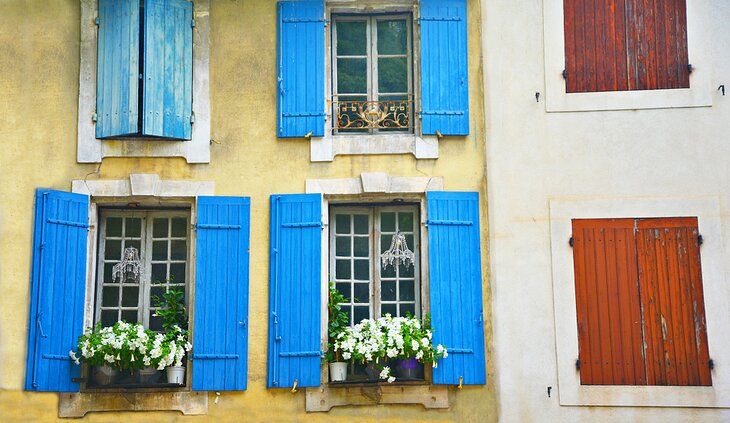
It's easy to see why Vincent van Gogh found inspiration in Saint-Rémy-de-Provence. This tranquil village in the northern foothills of the Alpilles Mountains rejuvenates the soul.
From 1889 to 1890, Van Gogh convalesced at the Monastère Saint-Paul de Mausole, a Romanesque monastery-turned-psychiatric hospital. During his stay, Van Gogh received the care of kind nurses and enjoyed the peaceful garden setting. Today, the former monastery/hospital is open to the public. You can visit the artist's room and see copies of the paintings he created here.
To learn more about the life and works of Van Gogh, an obligatory stop is the Musée Estrine (8 Rue Lucien Estrine) which has a Center of Interpretation devoted to the artist.
The Vincent van Gogh Trail indicates sites throughout the town that were painted by Van Gogh, although some imagination is required as the scenery has changed since the artist's time. The Office of Tourism in Saint-Rémy de Provence offers guided tours (by reservation) of the sites that Van Gogh painted.
Saint-Rémy de Provence is well known for its Provençal open-air market. On Wednesday mornings, the Grand Marché Provençal (large market) spills out onto the main squares of the old town. Be sure to visit the market for a chance to experience the local culture.
You will also find many other worthwhile things to do, such as attending an organ recital (on Saturdays at 5:30pm during the summer) at the Collégiale Saint-Martin, rebuilt in the 19th century in Neoclassical style.
Interested in ancient history? Explore the archaeological ruins at the Glanum Excavation Site, which has a Triumphal Arch from the 1st century BCE dedicated to Julius Caesar.
Gastronomic delights abound in Saint-Rémy de Provence, and you will enjoy sampling the regional specialties. La Roma (33 Boulevard Marceau) is an Italian restaurant and salon de thé (tea salon) known for its crêpes, ice cream, and macaroons.
Chocolate lovers should make a beeline for the Chocolaterie Joël Durand (3 Boulevard Victor Hugo), an upscale boutique that offers tantalizing chocolate candies in delicate flavors.
Le Petit Duc (7 Boulevard Victor Hugo) is a tempting shop that sells typical Provençal confections such as nougat (candy made with almonds and honey), crystallized violets, and calissons (sweet almond candies).
In the nearby village of Paradou, Le Bistro du Paradou (57 Avenue de la Vallée-des-Baux) is a favorite spot among locals. This restaurant specializes in traditional Provençal cuisine and offers a prix-fixe menu. Meals are served in a cozy old-fashioned dining room or on the outdoor terrace.
Also in Paradou is the Michelin-starred Cicada - La Table du Hameau restaurant, which offers creative seasonal cuisine served in an inviting outdoor setting or a modern dining room.
Saint-Rémy de Provence is about 25 kilometers north of Arles and 20 kilometers south of Avignon, which makes the town an excellent base in the heart of Provence.
Families seeking a countryside retreat near the village of Saint-Rémy will appreciate the Le Mas de l'Ange, a typical Provençal stone farmhouse. The entire property is available for rent including eight bedrooms, a swimming pool, and a private tennis court.
13. Salon-de-Provence: Historic Landmarks and Artisan Soaps
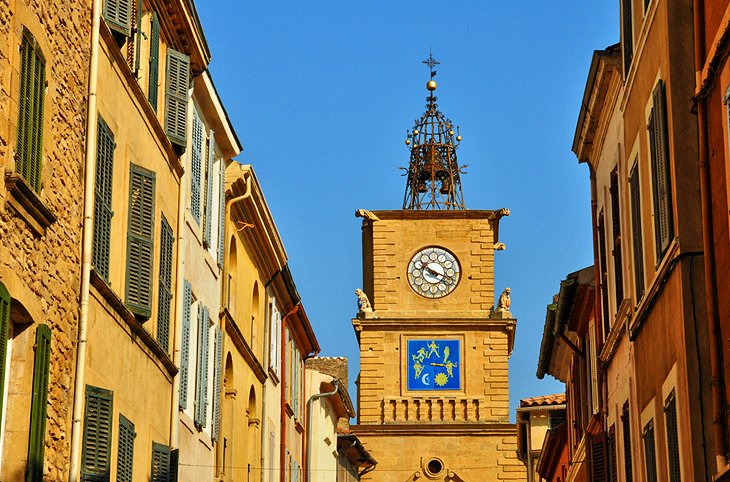
Salon-de-Provence gives the impression of being a sleepy town, surrounded by a bucolic landscape of olive groves and farmlands. However, this town has plenty of culture and an impressive heritage stretching back to the time of Charlemagne.
During the medieval era, the Archbishops of Arles built the fortress-like Château de l'Empéri ("Emperor's Castle"), which dominates the townscape. This 12th-15th century château has some of the best-preserved fortifications in Provence and a lovely Romanesque church, the Chapel of Saint-Cathérine.
The Maison de Nostradamus is where Nostradamus spent the last 20 years of his life. The house has been converted into a museum that displays original editions of Nostradamus' prophecies and a reproduction of his study.
Salon-de-Provence is synonymous with artisanal olive oil and fragrant soap products (sold all over France and beyond). To learn more about the history of soap production in Salon-de-Provence, take a guided tour at the Marius Fabre soap factory (148 Avenue Paul Bourret). The Marius Fabre company still produces artisanal soaps and has been recognized as an Entreprise du Patrimoine Vivant (Living Heritage Company).
Looking for a getaway in nature? Head to the Garrigae Abbaye de Sainte Croix in the nearby Luberon Natural Regional Park. This four-star hotel occupies the Abbaye de Sainte Croix, a renovated 12th-century Romanesque abbey. The hotel property encompasses 20 hectares of wooded rolling hills and affords superb vistas of the surrounding countryside.
14. Grasse: Perfumes, Gardens, and Art
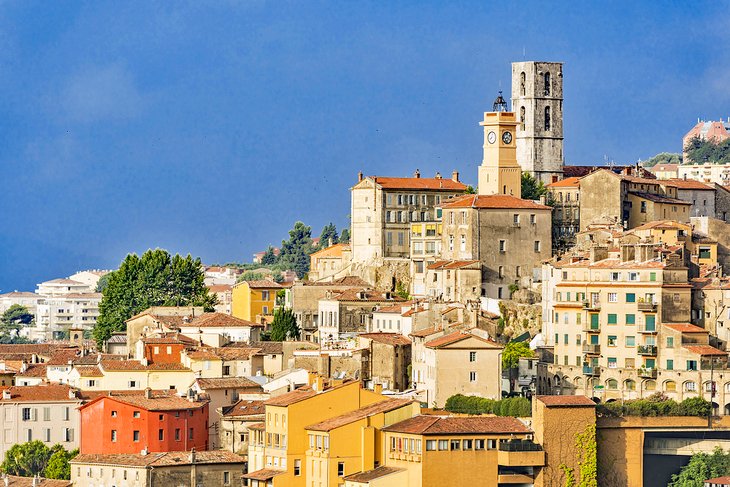
This quintessential Provençal hilltop town appeals to all the senses. The historic center (Vieille Ville) of Grasse is visually striking, with its brightly painted old buildings. Adding to the charm are atmospheric cobblestone streets and babbling fountains in hidden squares.
After taking in the picturesque scenery, your next experience will be in the olfactory realm. Grasse is world-famous for its perfume industry. The green rolling hills and plains around Grasse flourish with orange blossoms, roses, mimosa, jasmine, lavender, and violets, which provide the essential oils to make delicate fragrances.
At the Musée International de la Parfumerie (2 Boulevard du Jeu de Ballon), you will learn about the history of perfumes, soaps, and cosmetics and then can stop to smell the roses (or have a picnic) in the museum's gardens.
You can also tour the famous perfume factories, including Fragonard, Molinard, and Galimard. You can even sign up for a perfume workshop at Parfumerie Fragonard to create your own customized fragrance.
Other must-see attractions in Grasse are the Musée Jean-Honoré Fragonard (Hôtel de Villeneuve, 14 Rue Jean Ossola) that displays a collection of Fragonard's Rococo artworks and the Jardin de la Princesse Pauline, a verdant oasis that boasts panoramic views of the Vieille Ville and the rural landscape in the distance.
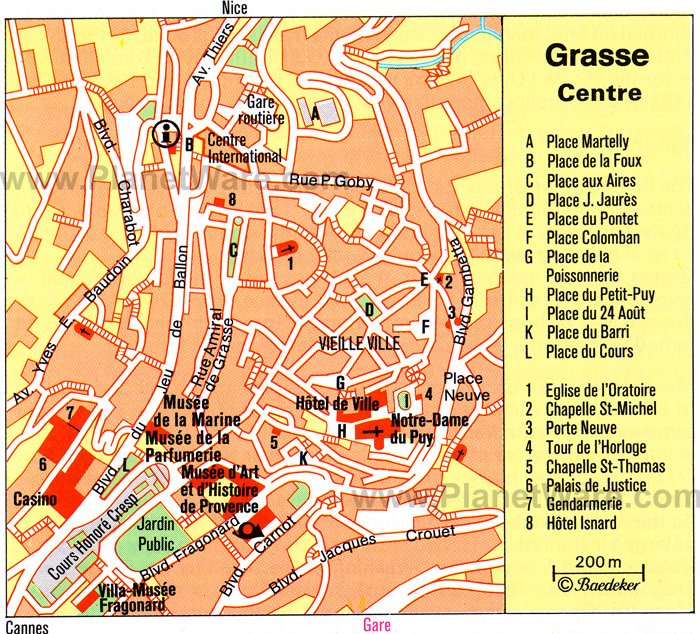
15. Sunbathing and Sightseeing in Fréjus
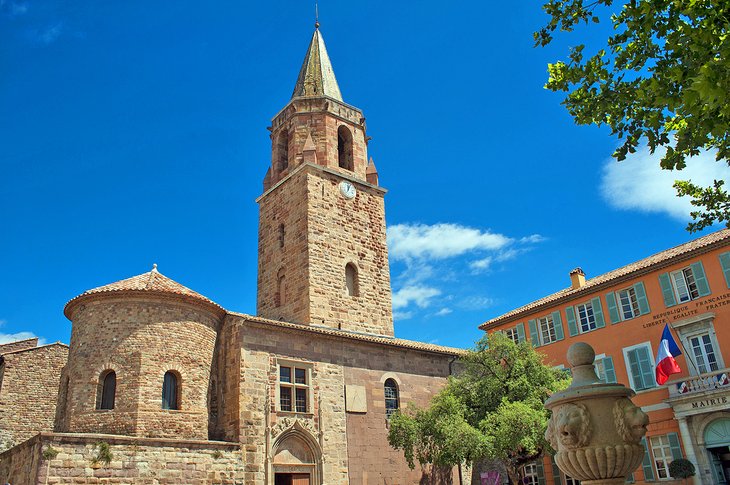
This sunny resort destination features a picturesque marina and sandy beaches on the sheltered Gulf of Fréjus. Tourists flock here during summertime.
Besides vacation ambience, Fréjus has plenty of culture. The Romanesque Cathédrale de Fréjus dates to the 11th to 12th centuries. While the cathedral's exterior is now hidden by more modern surrounding buildings, its spire soars high above the city's rooftops as a beacon of faith.
Next to the cathedral's cloisters, the Archaeology Museum (3 Place Calvini) displays an extensive collection of Greek and Roman artifacts. The museum also presents a model of the Roman city that once flourished here.
A testament to the city's ancient heritage is the 1st-2nd century Arènes de Fréjus (296 Rue Henri Vadon). This enormous monument (also called the Amphithéâtre Romain) once accommodated 12,000 spectators for gladiator fights.
The Arènes de Fréjus amphitheater provides modern-day audiences with fantastic entertainment during a summertime festival. Les Nuits Auréliennes includes a line-up of French-language theater performances. The ancient amphitheater is a magical venue for events held under the star-studded night skies of July.
Fréjus is 40 kilometers from Cannes, about a 35-minute drive away.
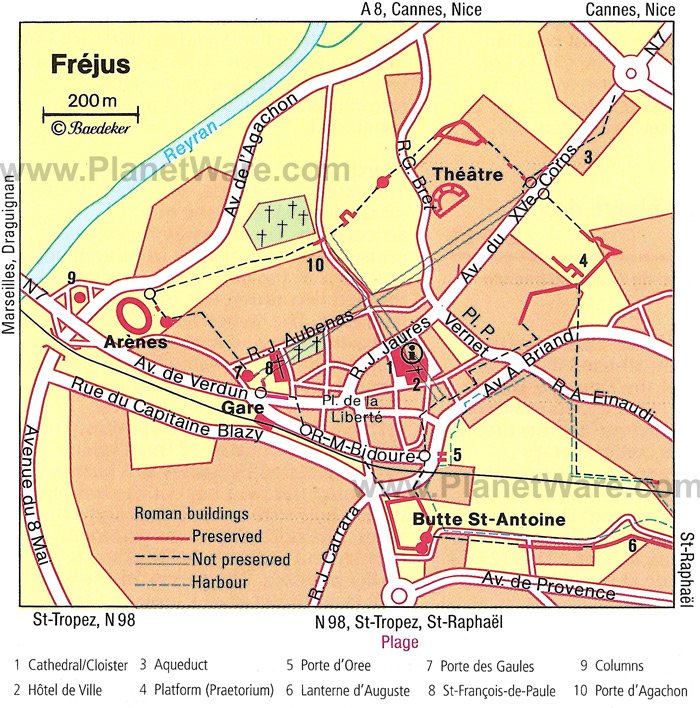
16. Cassis: A Quaint Fishing Village
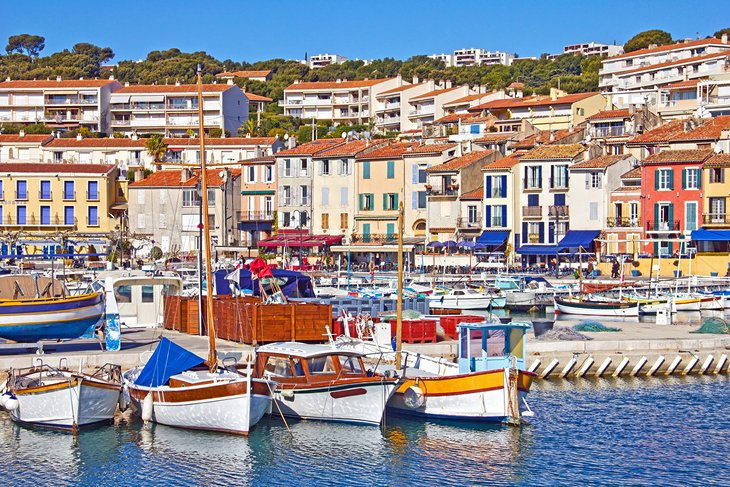
This quaint fishing village (and popular summertime holiday destination) has the vibrant ambience of a Mediterranean seaport combined with the traditional charm of Provence.
Cassis is 22 kilometers from Marseilles, yet feels much farther away in the countryside; it's a favorite getaway for residents of Marseilles seeking an escape to an idyllic setting.
The village enjoys a protected location on a semicircular bay framed by mountains. Because of its natural beauty, Cassis became an artists' village in the early 20th century. Resident artists captured scenes of colorful houses lining the harbor and small fishing boats docked in the marina.
Soak up the scenery by taking leisurely strolls along the waterfront and through the village. Lovely shaded squares and sunny terraces of outdoor cafés beckon you to stop and enjoy the moment.
Nearby beaches, a few kilometers outside of the town, attract many sun worshippers during the high season.
The medieval Château de Cassis has been converted into luxury accommodations (one-bedroom suites for couples and spacious two-bedroom suites for families). The property features an outdoor swimming pool and breathtaking views. From its hilltop vantage point, the château overlooks the village and harbor of Cassis, as well as the Mediterranean coastline.
17. Biot: An Ancient Perched Village with Artisan Boutiques
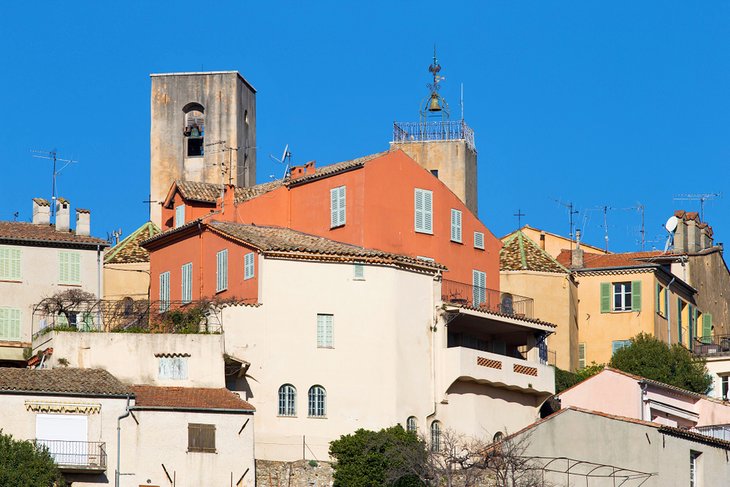
Built on the slopes of a steep hill, Biot is a medieval village perché (perched village) with many stepped pathways that lead to incredible viewpoints. Hidden wonders are yours to discover as you amble around the village's narrow cobblestone streets, quiet alleyways, and pleasant squares.
The village is also known for its arts and crafts boutiques that sell locally made jewelry, ceramics, glassware, and textiles. Many shops carry special artisanal products of the region, such as handmade soaps or tablecloths sewn from Provençal fabrics.
Biot's history is intertwined with the Crusades of the 12th century. The Eglise Sainte-Marie-Madeleine (Place de l'église) was built during this period. The sanctuary boasts an altarpiece, the Madonna with Rosary by Louis Bréa in the 16th century.
The village's more recent cultural heritage is seen at the Musée National Fernand Léger (255 Chemin du Val de Pôme) which displays a comprehensive collection of the modern artist Fernand Léger's works. Léger briefly lived in Biot; the museum is housed on the site of the artist's villa.
18. Saint-Paul-Trois-Châteaux: Culture, Cuisine, and Nature
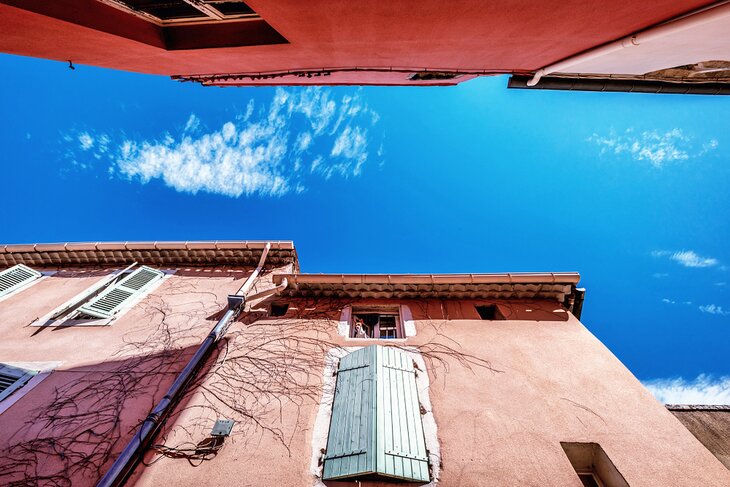
The quaint old streets of Saint-Paul-Trois-Châteaux invite you to take a walk back in time. Wander around the medieval lanes and discover the elegant hôtels particuliers (historic mansions).
At the heart of the village, the Cathedral Notre-Dame et Saint-Paul soars high above the town. This 12th-century church exemplifies Provençal Romanesque architecture, characterized by its simple layout and majestic spaces. The facade features intricate bas-reliefs and a porch with pillars that reference classical Roman columns, and the grandiose nave has vast dimensions.
Saint-Paul-Trois-Châteaux also has evidence of a Jewish community from the 12th to the 15th century. The Rue Juiverie is testimony to the medieval Jewish quarter. Here, the vestiges of a 15th-century synagogue (a stone arc that was used to hold the holy text) were discovered.
The Tricastin area surrounding this medieval village has an abundance of French truffles, also known as "black diamonds." Truffle purveyors take their prized culinary goods (Tuber Melanosporum) to the Saint-Paul-Trois-Châteaux Truffle Market on Tuesdays and Sundays (November through March). The Tuesday market is open to the public; the Sunday market is reserved for restaurateurs and private individuals.
A Truffle Festival takes place in Saint-Paul-Trois-Châteaux on the second Sunday in February. The festival includes tastings of local specialties prepared with truffles, like omelettes and truffled brie.
Luxurious accommodations are available at the Villa Augusta, surrounded by woodlands and lavender fields. This four-star hotel is a converted ancienne maison (historic Provençal villa) with impeccably decorated guest rooms and a fine-dining restaurant that serves the cuisine of the terroir.
19. Tarascon: Provençal Festivals and Fabrics
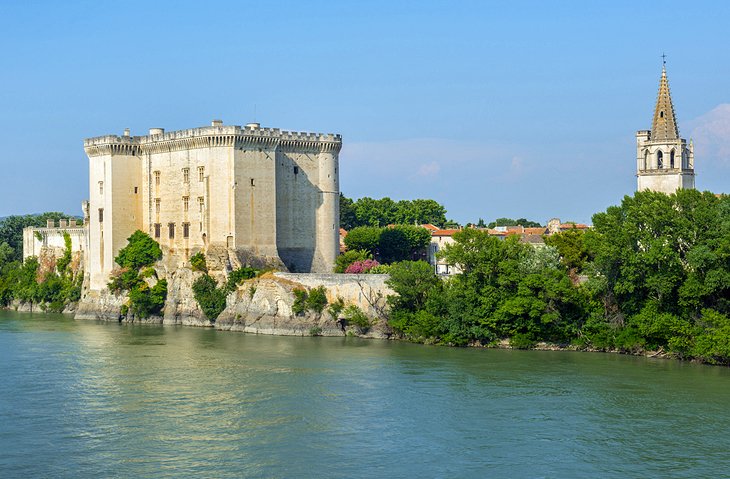
Tarascon exemplifies the art de vivre (lifestyle) of Provence, with its relaxing ambience and weekly gourmet market featuring regional products. The town is also known for its festivals.
You will enjoy exploring the old cobblestone lanes and arcaded streets, while admiring little chapels, cloisters, and historic mansions. The town's Château de Tarascon is considered one of the best-preserved medieval fortresses in France. The château is open to the public for visits year-round, although the opening hours/days are reduced in the off-season.
Tarascon's rich cultural heritage comes to life during Les Fêtes de la Tarasque in June. This UNESCO-listed festival dates back to the 15th century. Following the centuries-old traditions, townspeople dress up in medieval costumes, and a dragon-like mascot, La Tarasque, is paraded on a procession through the town.
The Musée Souleiado (39 Rue Charles Deméry) displays Provençal fabrics and exhibits about the history of traditional Provençal textiles. Souleiado sells its brightly printed Provençal cotton fabrics and designer clothing at boutiques in Aix-en-Provence, Arles, Avignon, and Paris.
20. Mougins: Picasso's Favorite Hilltop Village
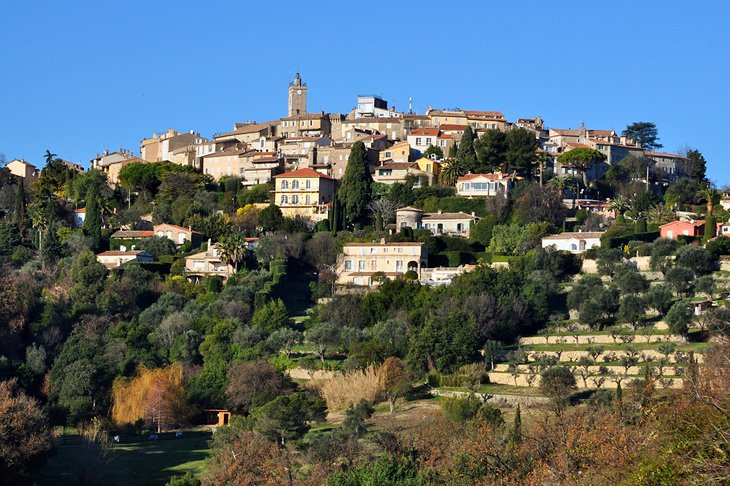
This typical Provençal hilltop village is worthy of a detour just to admire the exceptional views. From its perched vantage point, you can admire sweeping vistas of the rolling hills, as well as the coastline all the way to the Golfe de la Napoule in Cannes.
Drawn to the town's beauty, Picasso lived in Mougins from 1961 to 1973. He converted the Chapelle Notre-Dame de Vie into his art studio. This humble Provençal-style church is approached by a cypress tree-lined path reminiscent of landscapes in Tuscany.
The Chapelle Notre-Dame de Vie is open for visits every day in July and August, on weekends in May, June, and September, and on Sundays from October through April. The chapel's Treasury houses a small museum.
Take time to explore Mougins' charming pedestrian streets, quiet squares, little boutiques, art galleries, and artists' ateliers. Be sure to check out the village's parish church, the Eglise Saint-Jacques-le-Majeur (dating to the 11th century) found near a pleasant courtyard.
For such a tiny village, Mougins has a surprising number of gourmet restaurants. The local Mediterranean cuisine is based on olive oil; vegetables; and aromatic herbs such as rosemary, thyme, fennel, and tarragon.
The village has several renowned culinary establishments: La Place de Mougins, a chic restaurant with a menu that highlights fresh local ingredients; Le Moulin de Mougins, which has a charming outdoor patio dining area; and Le Candille, which offers seasonal Provençal cuisine in its stylish dining room or on a shaded terrace with views of the rolling hills around Mougins.
21. Lorgue: A Small Town with Grand Gastronomy
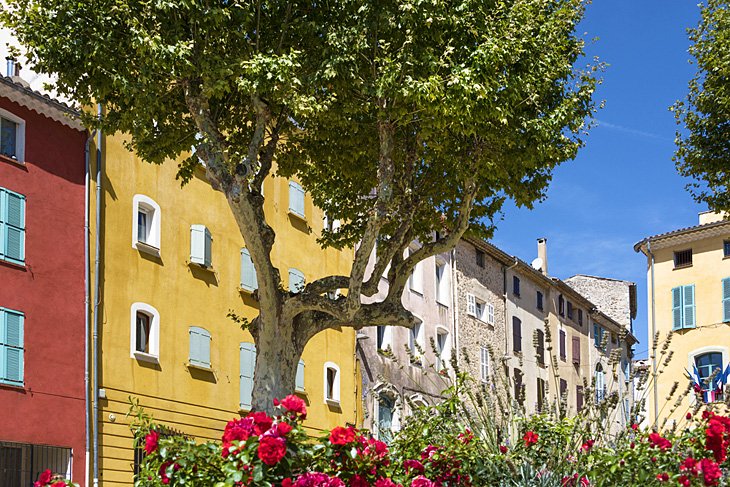
Off-the-beaten tourist path, Lorgue is a typical Provençal town with a historic church, gently flowing fountains, and a main square that hosts a weekly market.
The town nestles in a fertile countryside of lush woodlands and a patchwork of small farms. It's an ideal place to spend a quiet holiday, enjoying nature and gourmet cuisine.
There are many historic attractions nearby, including the village of Flayosc, known for its 11th-century church and ancient olive-oil mill surrounded by flourishing groves of olive trees.
Tourist highlights in the area include several renowned restaurants/hotels. The Château de Berne (Route de Salernes) is a luxurious five-star Relais & Châteaux hotel with a gastronomic restaurant. The Château de Berne also has a casual bistro, tennis courts, a swimming pool, an upscale spa, and hiking trails.
Nearby, in a beautiful garden setting, is the Michelin-starred restaurant Restaurant Bruno (2350 Route des Arcs, Le Plan Campagne Mariette, Lorgue). Chef Clément Bruno is known as the "Empereur de la Truffe" (Emperor of Truffles). The restaurant features classic French dishes made with seasonal truffles of the region and imported from regions such as Piedmont and Umbria in Italy, where white truffles are found.
22. Seillans: A Beautiful Perched Village
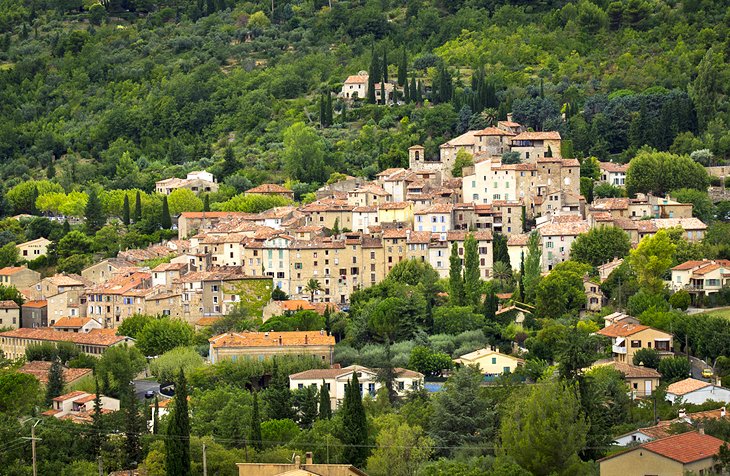
This alluring hilltop town is one of the Plus Beaux Villages de France. The charm of Seillans is found in its maze of medieval cobblestone lanes and alleyways. Within this enchanting pedestrian world are hidden surprises: fountain-adorned squares, vaulted passageways, small tree-shaded courtyards, and views of the vine-covered hills and olive groves that surround the town.
Typical in Provence, the village hosts weekly markets, and locals play pétanque at the main town square (Place de la République).
The village has two noteworthy churches: the 11th-century Romanesque church, Eglise Saint-Léger, and the Cistercian Provençal style Chapelle Notre-Dame de l'Ormeau, four kilometers outside the village.
The painter Max Ernst admired the beauty of Seillans and spent the last years of his life here. Some of his works are on display at the Maison Waldberg, where the art critic and writer Patrick Waldberg lived, and which now houses the Donations Max Ernst, Dorothéa Tanning et Stan Appenzeller (collections). Access is through the Tourism Office on the Place du Thouron.
Seillans is just seven kilometers away from Fayence, another pretty little medieval hilltop village. Fayence is appreciated for its pleasant rural setting and panoramic views of the Provençal countryside.
23. Bargème: A Peaceful Countryside Retreat
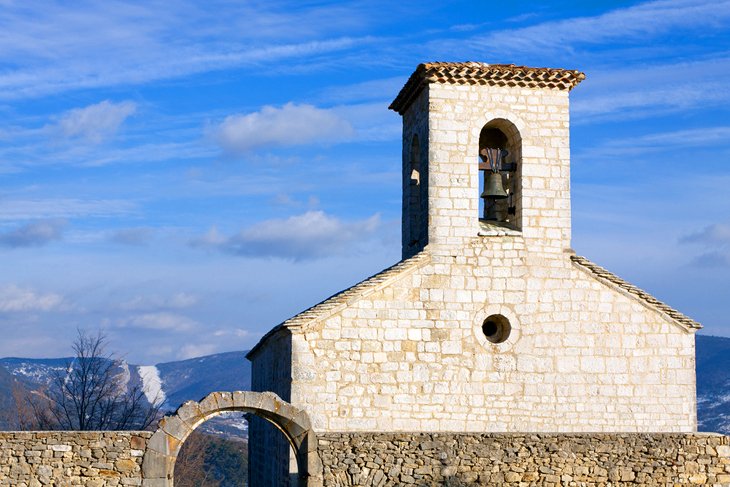
It's worth going a bit out of the way to visit this sleepy country village. Bargème brims with charm and beauty, enough to earn it a place on France's list of Plus Beaux Villages.
Clinging to a promontory over 1,000 meters above the rural landscape, Bargème has the distinction of being the highest elevated town in the Var department. The views from the village are truly astounding.
As a typical medieval hilltop town, Bargème features rampart gates, winding cobblestone streets, vaulted passageways, and old stone buildings. A jaunt through the villages leads to discoveries of historic churches, art galleries, outdoor cafés, and restaurants with terrace seating.
Two standout churches include the 12th-century Eglise Saint-Nicolas on the highest point in the village and the 17th-century Chapelle Notre-Dame des Sept Douleurs (also known as the Chapelle Notre-Dame d'Espaïme) near the château's esplanade. Vestiges of the old ramparts lie around the southern and eastern edges of the village.
Bargème once had a magnificent castle, the Château Sabran de Pontevès, which was built in the 13th century and destroyed during the War of Religions. The evocative ruins grace an elevated plateau overlooking an expanse of rolling hills, forests, and valleys.
About a one-hour drive away, the Parc Naturel Régional du Verdon (Natural Regional Park of Verdon) draws many visitors for its relaxation benefits and hiking opportunities. This regional park boasts some of the best hikes in France along with a spectacular nature site, the Gorges du Verdon, a dramatic canyon with cliffs that plunge 700 meters to the Verdon River.
24. Château de Rochegude
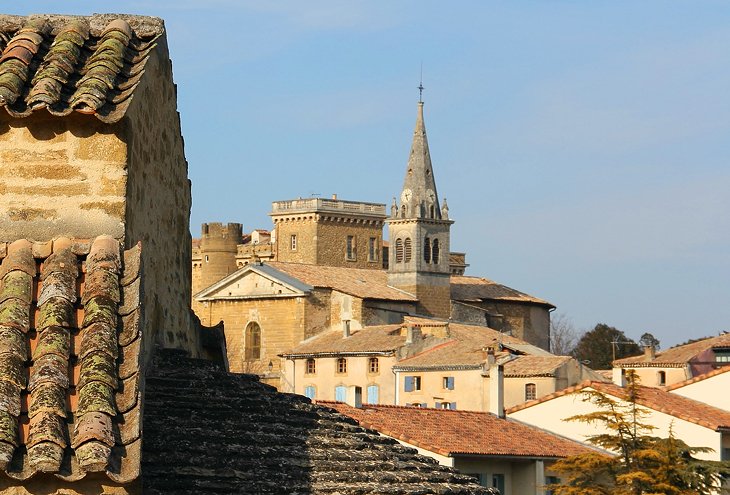
Vine-covered rolling hills of the Côtes-du-Rhône surround the tiny medieval village of Rochegude. The main tourist draw is the Château de Rochegude, a 12th-century fortress that was once the summer residence of the Marquis de Rochegude.
Updated during the Renaissance and recently renovated, the château has been converted into a four-star hotel. The luxurious guest rooms and suites feature classic French décor and modern amenities such as flat-screen televisions. The property has a park with outdoor terraces and a swimming pool, a full-service spa that offers massage treatments, and a gastronomic restaurant.
The area around Rochegude is renowned for its cuisine, including dishes made with the local delicacy of truffles. The nearby Haut-Vaucluse region also has many historic attractions, including two ancient towns with amazing Roman ruins: Orange (14 kilometers away) and Vaison-la-Romaine (27 kilometers away).
25. Aureille in Les Alpilles Mountains
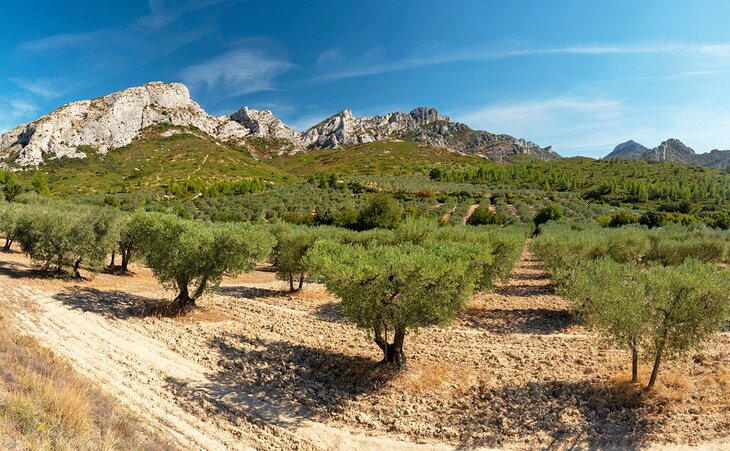
Aureille is a tiny country town with a captivating Provençal ambience. You will be charmed by the distinctive old stone buildings, narrow pedestrian streets, and pristine natural surroundings.
This quiet village becomes quite lively during summertime, when several festivals take place. The historic parish church also celebrates its Saint's Day in mid-August.
For travelers exploring Provence by car, Aureille is a good stopping point on the way to Les Baux de Provence or Saint-Rémy de Provence (both about 20 kilometers away). The village is in the heart of Les Alpilles Mountains, a pastoral area with many hiking trails and ancient traditions.
Scenic Drives through the Provence Countryside
1. Gorges du Verdon: Beautiful Views and Gourmet Cuisine
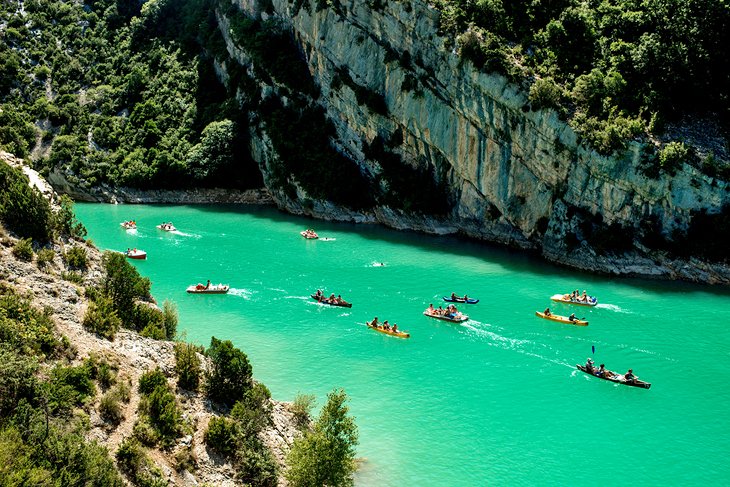
Nature lovers will enjoy a driving tour through the Gorges du Verdon in the Parc Naturel Régional du Verdon (Natural Regional Park of Verdon). The best starting point for a tour of the Grand Canyon du Verdon is the little town of Castellane on Route Napoléon.
Take the road D952 in a southwesterly direction downstream through the Defile of Porte Saint-Jean and Clue de Chasteuil. At the fork, in about 12 kilometers, bear left on the D955, cross the river at the Pont de Soleils bridge (signposted "Rive Gauche"), and continue south over the uplands. Approximately six kilometers beyond the fork is the picturesque village of Trigance with its imposing château.
For a meal or overnight stop, take a 12-kilometer detour from Trigance to the Auberge du Point Sublime in a tranquil setting in the little village of Rougon. The hotel's restaurant has a shaded terrace and features traditional cuisine made with local artisanal ingredients.
The Point Sublime in Rougon is the finest viewpoint on the drive through the Grand Canyon du Verdon. In La Palud-sur-Verdon (15 kilometers from Rougon), the Belvédère de L'Escalès offers another incredible viewpoint.
After returning from Rougon to Trigance, take the D90 road as far as the D71 road. About ten kilometers from Trigance is the Balcons de la Mescla, the first high spot of the drive through the Grand Canyon du Verdon. This point offers a marvelous panorama of the landscape.
The Corniche Sublime continues from the Balcons de la Mescla along its winding course with breathtaking views high above the Gorges du Verdon and through the Tunnels de Fayet.
Continuing 10 more kilometers from the Balcons de la Mescla in the direction of Aiguines, you will find the Hôtel du Grand Canyon du Verdon perched on a hillside 300 meters above the Gorges du Verdon. The hotel's sunny terrace and dining room overlook the canyon. After a day of outdoor activity, guests will appreciate the restaurant's hearty meals that include specialties of the terroir.
If you enjoy water sports, it's worth a detour to the Lac de Sainte-Croix near the village of Moustiers Sainte-Marie, one of the Most Beautiful Villages of France. This pristine lake has a small beach and is ideal for swimming, fishing, boating, sailing, and windsurfing. The area around the lake also has camping sites.
2. Gorges du Loup: Gorgeous Scenery & Hilltop Villages
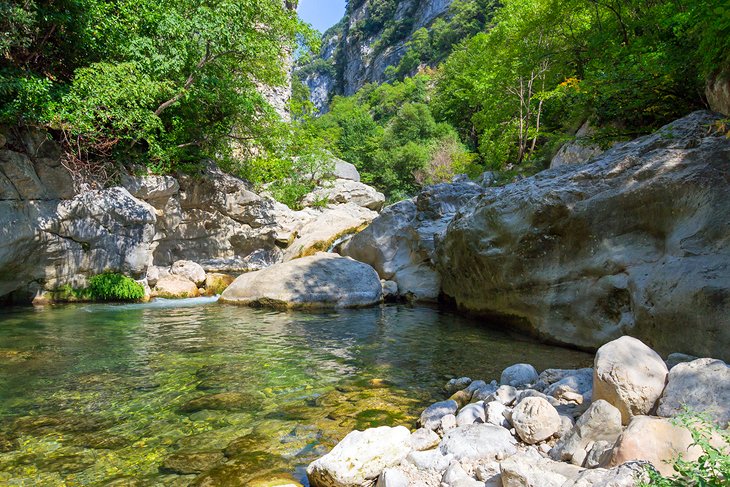
The Gorges du Loup was formed by the Loup River, which cut deep into the rock creating an immense ravine. This spectacular area of the Provence countryside is dotted with medieval villages perchés (perched villages).
Begin a tour in the hilltop village of Grasse, surrounded by fields of flowers and famous for its perfume. Then drive about ten kilometers on the D2085 and D2210 roads until reaching the tiny perched village of Le Bar-sur-Loup.
From Bar-sur-Loup, a circuitous route of about 11 kilometers leads to the ancient village of Gourdon, (one of the Most Beautiful Villages of France) sitting on a steep rocky peak overlooking the rural landscape. The Château de Gourdon has exquisite gardens designed by André Le Nôtre. Also worth visiting are Gourdon's two Romanesque churches: the Chapelle Saint-Pons and the Eglise Saint-Vincent.
From Gourdon, take the D3 road to the D6 road that travels around the rock walls through the gorge up to the Saut du Loup, a scenic area in the hills with views of the Cascade de Courmes (waterfalls). Near a winding stretch of the D3 road, an observation point (signpost "Surplomb des Gorges du Loup") offers a stunning vertical view down into the gorge and up to Pic des Courmettes (mountains).
About 12 kilometers from Saut du Loup (and five kilometers from Vence) is the lovely village of Tourrettes-sur-Loup. This hilltop town presides above the Loup Valley and the rolling hills of the Côte d'Azur backcountry. Originally fortified, the well-preserved medieval village is surrounded by olive groves, pine woods, and fields of violets (used to make the local specialty of crystallized violets).
You enter Tourrettes-sur-Loup through an old gateway, which leads to the central square and a jumble of cobblestone lanes with shaded courtyards and outdoor cafés.
Since the 1940s, the beauty of Tourrettes-sur-Loup has drawn many artists, writers, and musicians. Today, the village has dozens of art studios and galleries, as well as artisan boutiques that sell locally made ceramics, paintings, sculpture, textiles, and jewelry.



